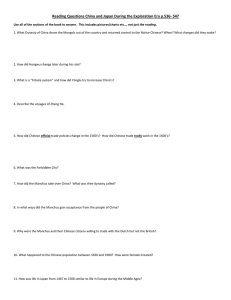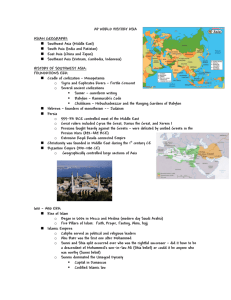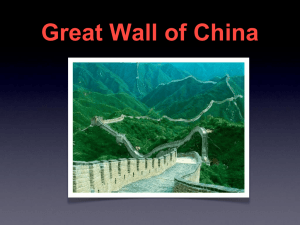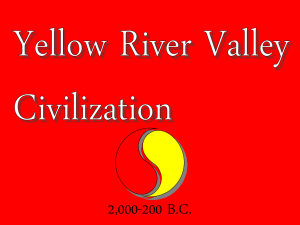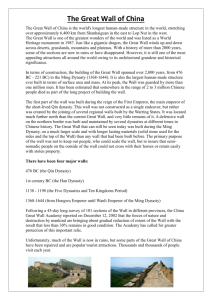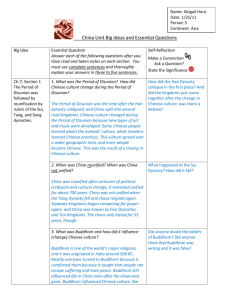HISTORY OF EAST ASIA: China and Japan Know the order of all of
advertisement
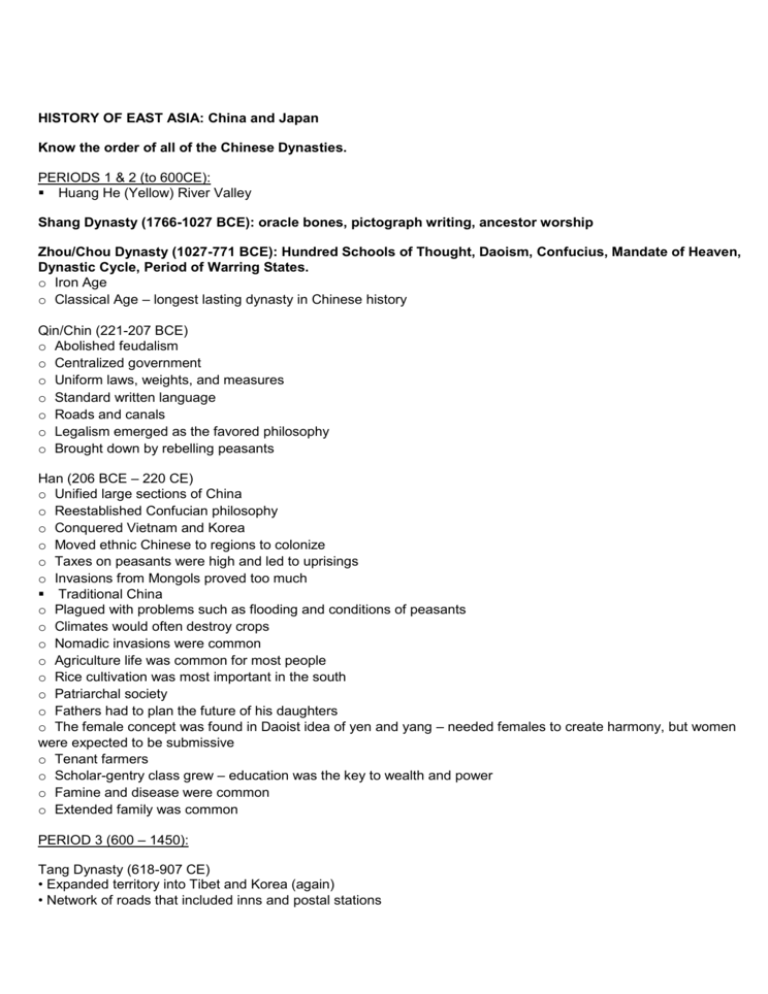
HISTORY OF EAST ASIA: China and Japan Know the order of all of the Chinese Dynasties. PERIODS 1 & 2 (to 600CE): Huang He (Yellow) River Valley Shang Dynasty (1766-1027 BCE): oracle bones, pictograph writing, ancestor worship Zhou/Chou Dynasty (1027-771 BCE): Hundred Schools of Thought, Daoism, Confucius, Mandate of Heaven, Dynastic Cycle, Period of Warring States. o Iron Age o Classical Age – longest lasting dynasty in Chinese history Qin/Chin (221-207 BCE) o Abolished feudalism o Centralized government o Uniform laws, weights, and measures o Standard written language o Roads and canals o Legalism emerged as the favored philosophy o Brought down by rebelling peasants Han (206 BCE – 220 CE) o Unified large sections of China o Reestablished Confucian philosophy o Conquered Vietnam and Korea o Moved ethnic Chinese to regions to colonize o Taxes on peasants were high and led to uprisings o Invasions from Mongols proved too much Traditional China o Plagued with problems such as flooding and conditions of peasants o Climates would often destroy crops o Nomadic invasions were common o Agriculture life was common for most people o Rice cultivation was most important in the south o Patriarchal society o Fathers had to plan the future of his daughters o The female concept was found in Daoist idea of yen and yang – needed females to create harmony, but women were expected to be submissive o Tenant farmers o Scholar-gentry class grew – education was the key to wealth and power o Famine and disease were common o Extended family was common PERIOD 3 (600 – 1450): Tang Dynasty (618-907 CE) • Expanded territory into Tibet and Korea (again) • Network of roads that included inns and postal stations • Buddhism became dominant • Confucian meritocracy was embedded in government through the Civil Service Exams • Set up tribute states – kowtow ceremony • Middle Kingdom – thought they were the center of the world – superior to foreigners • Taxation led to a decline of power and a rise of peasant unrest • Regional warlords followed Song Dynasty (960-1279): Reunified China, Silk Road, Technology, Printing, Urbanization, Neo Confucianism Mongols (1278-1368 CE) • Genghis Khan was the leader • Established the Yuan Dynasty of China Segregated Mongols and Chinese – marriage was forbidden, Chinese could not learn Mongol language Abolished Civil Service Exams and put Mongols in MOST offices Extended the Grand Canal to link most cities Visited by Marco Polo • Largest land empire in the world • Kublai Khan replaced Genghis • Mongol tribes also conquered Russia, Hungary, and India • Created a period of Pax Mongolica • Spread concepts to areas conquered Postal system Trade enhanced Paper money • Military Organization Leaders were chosen by ability, regardless of background Armor Flanking maneuvers Horseback fighting • Decline Good at conquering, not administering Ming Dynasty (1368 – 1644 CE): Civil Service Exam, Scholar-Gentry, Forbidden City, Maritime Trade for a time then Xenophobia, Japan • Islands limited trade and other opportunities, but provided protection from invasion (Mongols tried to, but couldn’t) • Contact with China was influential Nara Period (710 – 784) Contact with China Language Buddhism Court etiquette Architecture Heian Period (794 – 1185) Isolation of the emperor – believed to be a descendent of the Sun God Rise of power of families and clans Women wrote literature Fujiwara Clan emerged after 1000 and: • Increased literary and cultural achievements • Confucian and Daoist ideas Kamakura Shogunate develops under the influence of the Minamoto Clan • Samurai, Shoguns, and Bushido defined the Japanese Feudal System Ashikaga Shogunate Family gained control in 1333 Wealthy merchant class emerged Trade with China was common Buddhism continued to spread and change Tea ceremony Noh theater and gardening were common Haiku poetry PERIOD 4 (1450 – 1750): Ming Dynasty begins to decline o Weak emperors o Court eunuchs gained too much power and were corrupt o Scandals of funds o Scholar-gentry protested o Invaders o High taxes on peasants o Asked Manchus to help defend them Qing/Manchu Dynasty (1644 – 1911) o Manchus took over China o Saw themselves as separate from Chinese o Civil service exams o Neo-Confucianism o Obedience to ruler o Xenophobic foreign policy o Marriage between Manchus and Chinese was forbidden o Han (Chinese) men had to wear ponytail (que) o Resisted efforts by Europeans to trade Japanese Warring States (1467 – 1600 CE) o Defiance of the Shogun led to political fragmentation o Over 200 lords fighting each other o Buddhism attracted Samurais who sought to ignore pain o Portuguese arrived with Jesuits and firearms o 1600 battle led to the emergence of the Tokugawa Shogunate Tokugawa Shogunate (1600 – 1750) o Strengthened the feudal system o Social structure included Eta – outcasts who did unclean work o Social Structure defined at birth o Farmers had to stay on land o Only Samurai could carry weapons o One Dutch ship could arrive once each year for trade o Families of nobles had to live in Tokyo (Edo) to guarantee loyalty o Christianity was outlawed PERIOD 5 (1750 – 1900): Qing Decline: Opium Wars, Taiping Rebellion, Sino Japanese War. Chinese Revolution begins :Sun Yat Sen Those who had traveled outside of China wanted reforms o Sun Yat Sen led the revolutionaries o 1911 Qing abdicated Japanese Feudalism Ends o 1853 American Matthew Perry arrived with a show of American power and enticements o Japan agreed to trade with the U.S. o Beginnings of rapid industrialization organized by the government o Feudal lords lose power as factions gain gun powder PERIOD 6 (1914 to Present): Japan gained colonies throughout the 19th and 20th centuries o Russo Japanese War In 1931 Japan invaded Manchuria (China) and set off World War II o Other countries (U.S.) cut Japan’s supply of oil thinking that would reign them in, instead they decide to attack Pearl Harbor (1941) o Pacific War mainly fought between Japan and the U.S. o In 1945 the United States dropped two atomic bombs on Japan to get them to surrender o As a condition of the end of the war, Japan was limited in an armed force, so they devote significant amounts of money to industry and technology – setting Japan up to be the economic powerhouse of the late 20th century. China had participated in both WWI and WWII and was a “victor” in each o After war, China dealt with internal issues o Chiang Kai Shek emerged to challenge the socialism of Sun Yat Sen o This led to the Communist Revolution of China in 1949 o Chiang Kai Shek’s forces go to Taiwan and soon Sun Yat Sen is replaced by Mao Zedong HISTORY OF SOUTHEAST ASIA Khmer Empire o Located in Cambodia o Influenced by both Hinduism and Buddhism o Traded with Song China and Malaya o Built massive temples, most famous was Angkor Wat Vietnam o Continued efforts throughout to break free from Chinese domination o Successfully defended themselves against the Mongols – without a typhoon to help them o Ming dominated them o Women had more autonomy than in other parts of Asia PERIOD 6 (1900 – Present): The French colonized Indochina. 1954 France granted Vietnam, Cambodia, and Laos its independence When communists took over Vietnam factions, the United States entered the conflict to fight the spread of communism. Russia and China (both Communists) supported the Viet Cong (northern Vietnamese) against the United States. o Pacific War mainly fought between Japan and the U.S with Japan having increasing influence in SE Asia.
